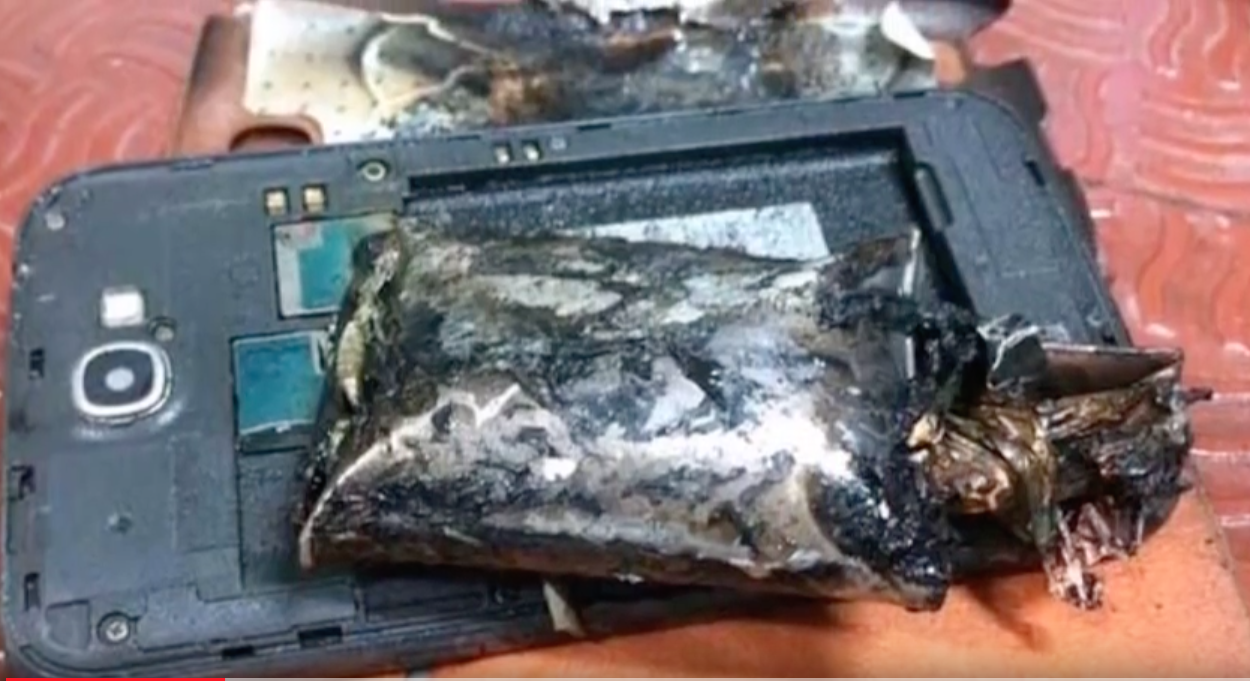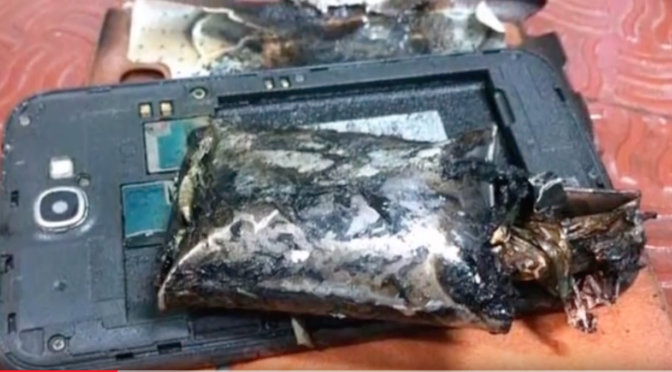A cell phone fire onboard a Southwest Airlines jet parked at the jetway made news recently. Apparently, the phone was off and in the passenger’s pocket when it ignited. He managed to yank it from his pocket and throw it to the floor. The phone promptly set the carpet on fire before both were extinguished. Smoke filled the cabin, so the passengers evacuated.
I wondered if similar events have occurred in flight. Sure enough, they have.
“Just over the arrival fix, a flight attendant called to report a fire in the cabin. A cell phone had caught fire while charging,” wrote one captain in his report to NASA’s Aviation Safety Reporting System.

Samsung Galaxy Note 2 that caught on fire during a flight on an airliner. (Photo from YouTube)
According to the flight attendants, the owner managed to fling the fiery phone into the aisle. Flames 8-12 inches high were reported before other passengers doused them with their drinks. While the captain set the air conditioning packs to high to clear all cabin smoke, the first officer got permission from ATC to maintain 280 knots to the marker. The flight landed uneventfully.
These incidents call to mind the 1992 crash of ValuJet Flight 592. Expired oxygen canisters in the cargo hold caught fire, rapidly burning out of control. Smoke consumed the cockpit and the plane nosedived into the Everglades. All on board perished.
ValuJet Flight 592’s crash resulted in additional safety regulations that expanded the use of fire suppression equipment in cargo holds.
Now we have self-immolating cell phones. Everyone’s got a cell phone. Regulation may be impossible. I’ve come to look back fondly on the good old days when all pilots had to worry about cell phones was their possible interference with navigation radios.
One low overcast day, I was captain on a J-41 turboprop. We were lined up for takeoff on Runway 13 at KLGA when the flight attendant phoned the flight deck. A passenger was refusing to turn off his cell phone. We were staring at a 300-foot ceiling, a rapidly closing temperature dew point spread and icing on for the climb.
I had no proof that cell phone interference was true, but I wasn’t about to risk it, given the complicated Goldman Departure Procedure assigned us, much less negotiating a tricky takeoff alternate scenario in busy New York airspace.
So I called ATC about “a situation in the back” and got clearance to exit the runway. After I made the PA explaining why, the other passengers managed to embarrass the cell phone offender into shutting off his device.
Back then, I had no evidence to prove what was true versus what was company policy. Now I do. At least seven NASA reports were filed recently about incidents in which cell phone signals compromised flight.
In one, a 737 flight crew was nine miles west of KBUR in busy Los Angeles airspace when they selected the approach mode on their autopilot. Both pilots watched it capture the localizer and intercept the course.
“I glanced at the altimeter to calculate where my alt callouts would be made. When I looked back over to my primary flight instruments, I noticed we had flown through our inbound course, and the aircraft was in a 30° left-hand bank.”
In fact, the autopilot had self-selected into lateral mode. That mode is a way for the autopilot to direct the aircraft horizontally in space. In approach mode the autopilot also will track the glide slope and direct the plane vertically toward a landing attempt. This autopilot steered into a 30° bank and flew the plane through the course before both pilots recognized the situation.
The deviation was particularly perilous because it occurred along the departure paths of Runways 16L and 16R at KVNY, a neighboring airport to KBUR. KVNY is known for the enormous amount of rich and famous private jet traffic it handles. Gulfstream vs. 737 = bad day.
Safely on the ground, the crew debriefed. The flight attendants confirmed they saw one of the passengers using a cell phone while the aircraft was on the approach.
In another report, a flight crew reported cell phone interference on their communication radios while taxiing away from the gate at KORD. The captain made a PA announcement reminding folks to turn off their cell phones. The radio interference ceased.
However, inbound to KCHA on the ILS approach, they experienced a similar phenomenon. Just outside the Final Approach Fix, the flight crew heard cell phone conversation bleed through their comm radios.
Although they landed without incident, both pilots were distracted by the cell phone interference and failed to hear on which frequency they were supposed to be while taxiing to the gate.
Can cell phones really interfere with aviation communication and navigation radio signals? It’s possible. Most aviation comm and navigation radio frequencies operate in the very high frequency radio band. Cell phones operate in a set of radio frequency ranges within the ultra-high frequency band. Those two bands are adjacent, so band bleed is theoretically possible. After all, boundaries between frequency ranges aren’t hard or impenetrable.
Another consideration is that the U.S. military uses the UHF band for its aviation comms and navs. Simulcasting on both civilian and military frequencies could create an opportunity for UHF cell phone interference, especially if the radio has a bad antenna.
And as any electrical engineer will tell you, a radio is only as good as its antenna.
Poor modulation by a failing receiver can be a contributing factor. In fact some cell phone networks are assigned frequencies shared by radio communication and fixed service entities. Signal leakage can occur from the condition of those facilities.
A 727 flight crew reported a similar problem while on approach into KATL. Numerous thunderstorms in the local area at the time of the approach caused ATC to vector the 727 and to change the intended runway from 27L to 26R. Upon localizer intercept, the captain noted a full-scale deflection of the needle on his course deviation indicator. When he turned to intercept it, another full-scale deflection occurred in the opposite direction. ATC issued a go-around.
At the time, the captain thought he had a problem with his receiver. On the second attempt, post go-around, both the captain’s and first officer’s receivers were tuned to the same localizer frequency. An uneventful landing was made. A flight attendant reported to the crew that just before that anomalous event a cell phone had begun ringing in the cabin. A passenger apparently answered the phone and initiated a conversation.
Atlanta is a super busy airport — five parallel runways, all active all the time. A full-scale deflection at that proximity and it’s an airshow wingman disaster waiting to happen.
Back in 2002, a CRJ pilot wrote of three such incidents encountered: “While in level flight awaiting capture of the localizer, the autopilot began a standard rate turn to the inbound course approximately seven miles prior to intercepting the localizer.” The crew immediately disconnected the autopilot and hand flew the rest of the approach.
After landing and deplaning passengers, the captain queried the flight attendant about possible passenger cell phone use during the approach. She stated that she had observed someone making a call during the approach.
The reporting pilot wrote, “This type of autopilot error has happened to me at another airport, and I suspected cell phone interference. However, I was never able to prove that someone was actually using their phone inflight. On this occasion, it was confirmed by the flight attendant.”
He raised legitimate concerns that traffic conflicts or even controlled flight into terrain could result from cell phone interference.
That same pilot offered the following: “I would like to offer a possible solution. Implement a receiver/detector on board the aircraft, which can detect transmissions by these types of devices. With this info, the crew would at least have some indication in that there is the possibility of interference. The crew would then take an appropriate course of action.” Today, 14 years later, nothing.
Apparently, a cell phone doesn’t even have to be on an airplane for it to be hazardous to one. One pilot filed a NASA report after a near miss with baggage cart tug.
“We were directed to park our aircraft in Gate X. We initiated the turn without having to stop. About one-third of the way thru the turn-in, I sensed in my left peripheral vision a fast movement and quickly realized a tug pulling two or three heavy baggage carts was shooting through an open gap between our parking silhouette and the aircraft to our immediate left. I initiated an emergency stop.”
That move locked up all four tires on the left main landing gear truck, causing a severe side torque on the nose wheel. It also twisted the nose of the aircraft enough to buckle the airframe, causing the locked right aircraft entry door to break open.
The tug driver finally looked up and slammed on his brakes, averting a collision with the aircraft nose. Wrote the pilot, “I suspect a cell phone may have been involved…”
Source: http://generalaviationnews.comCell phones and airplanes: A deadly combination
